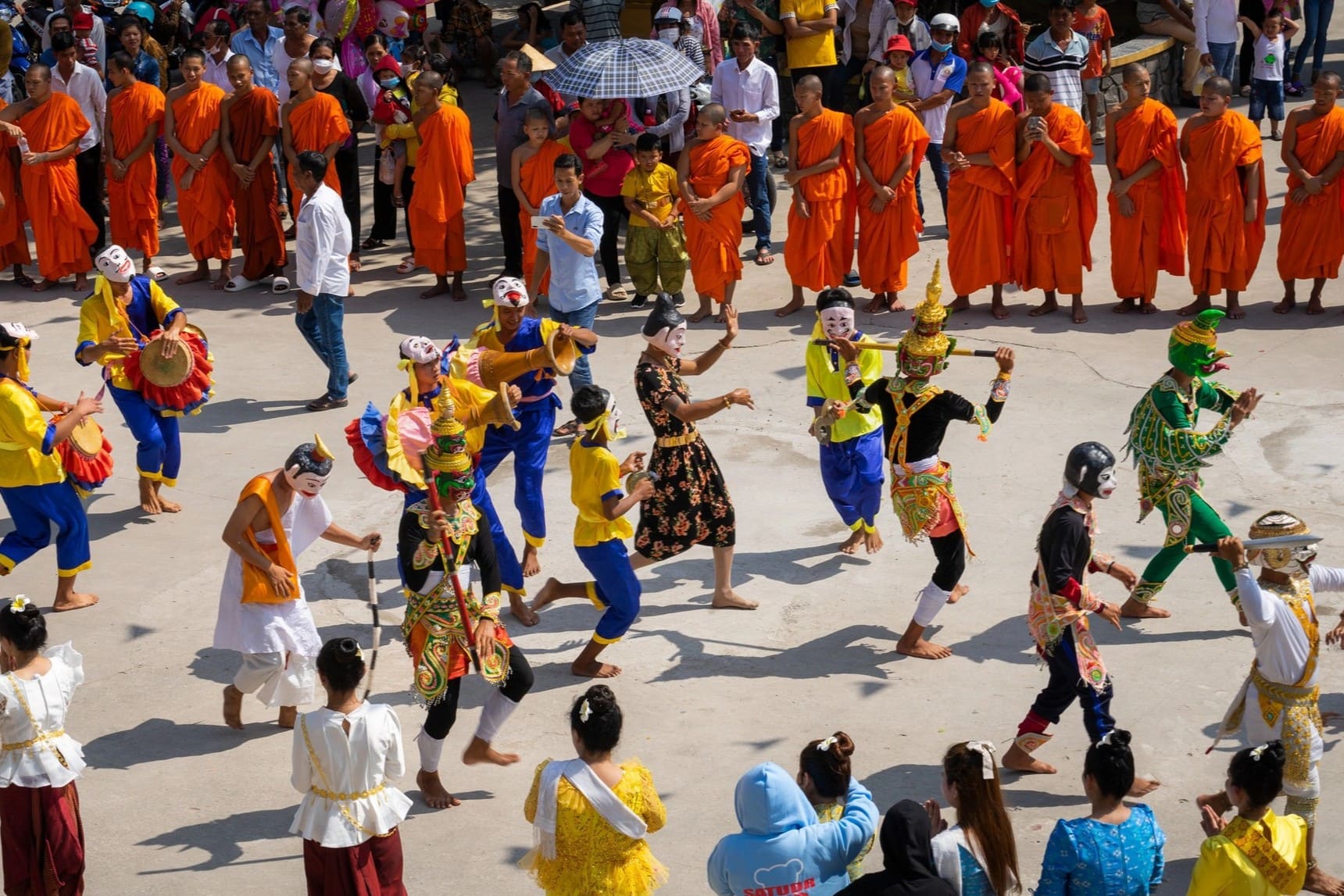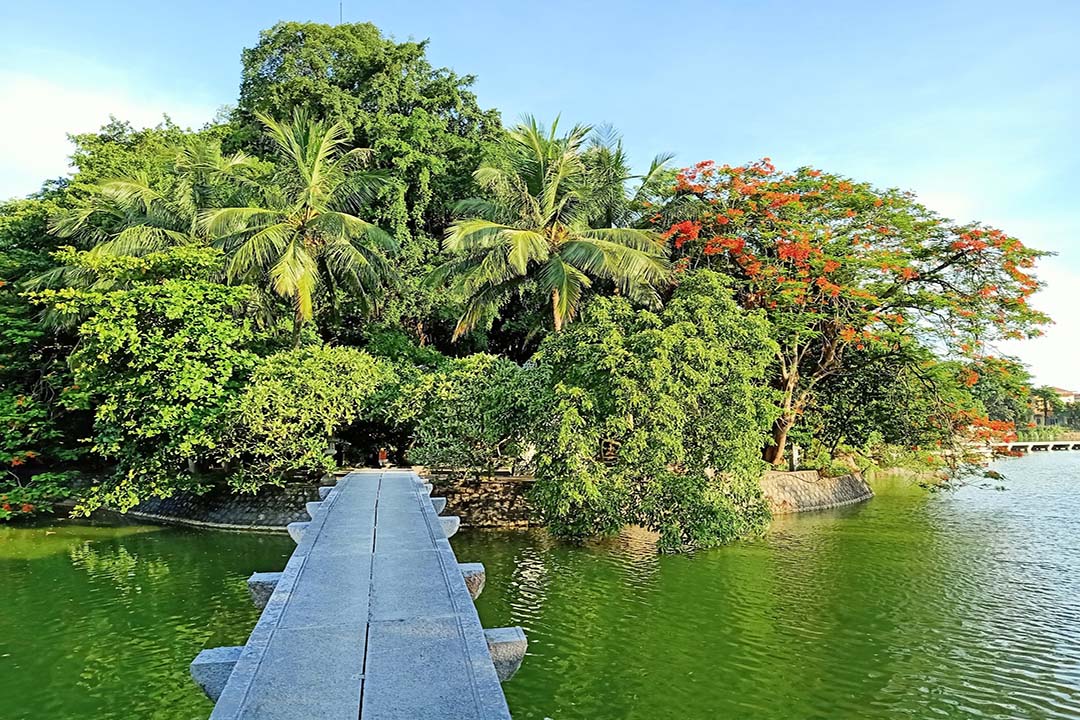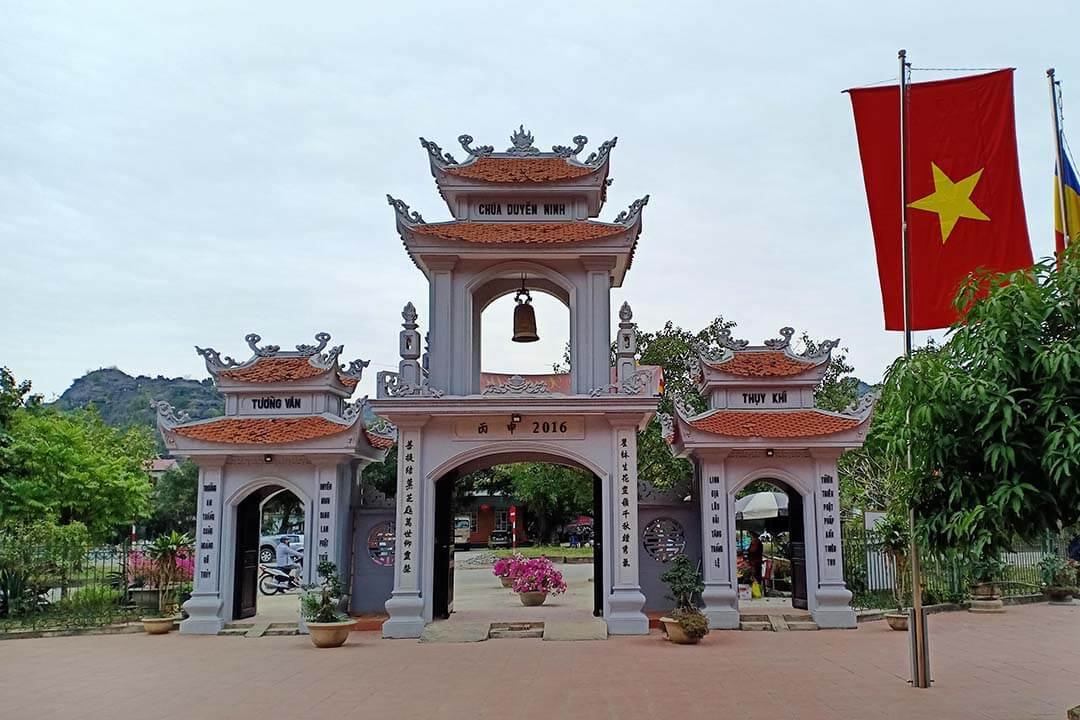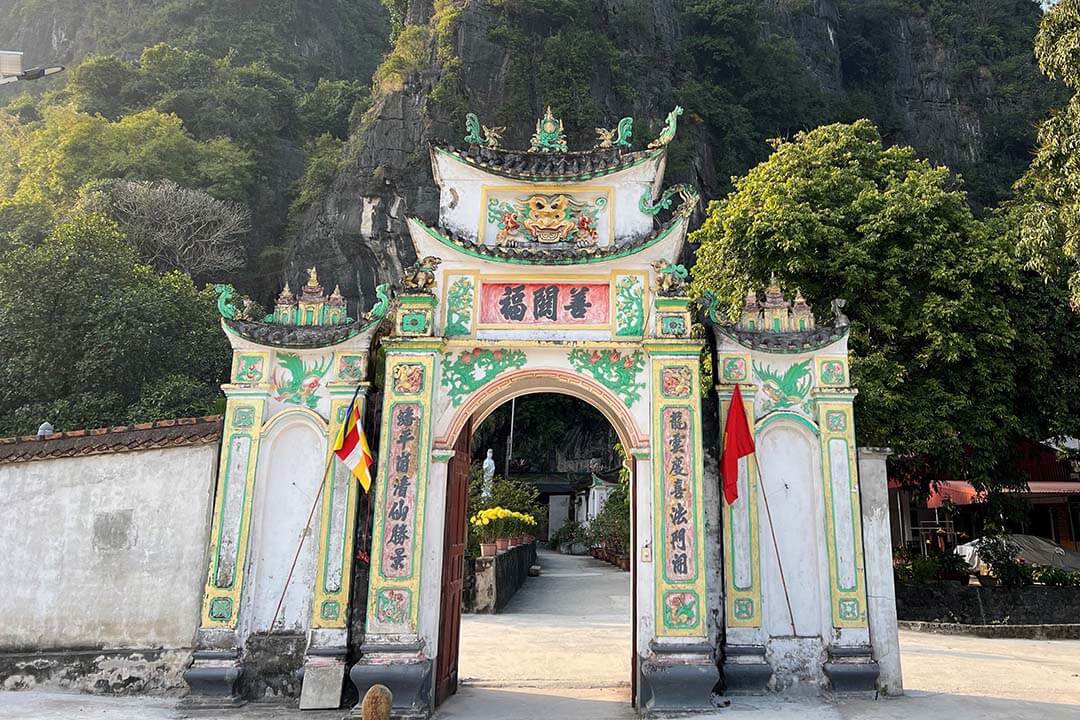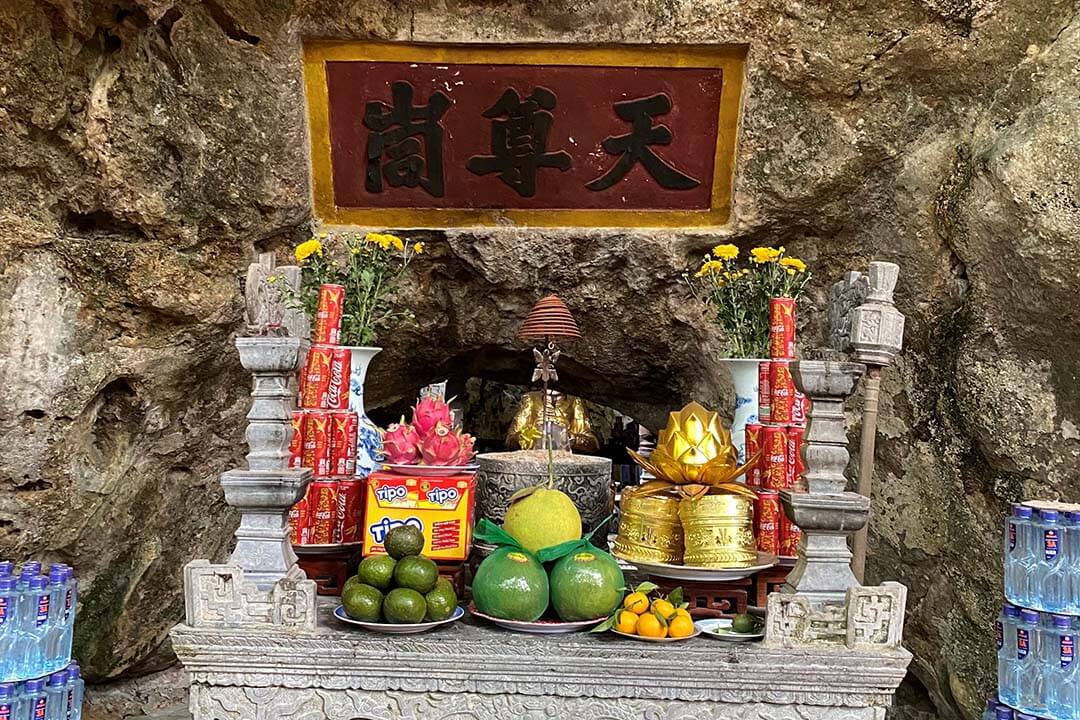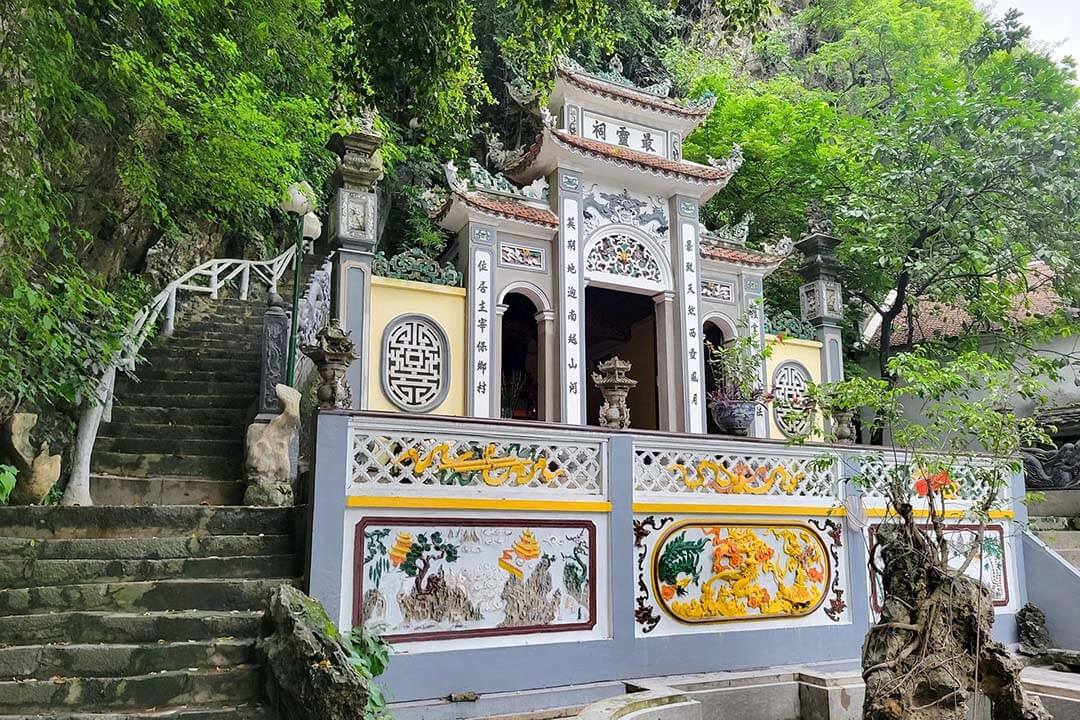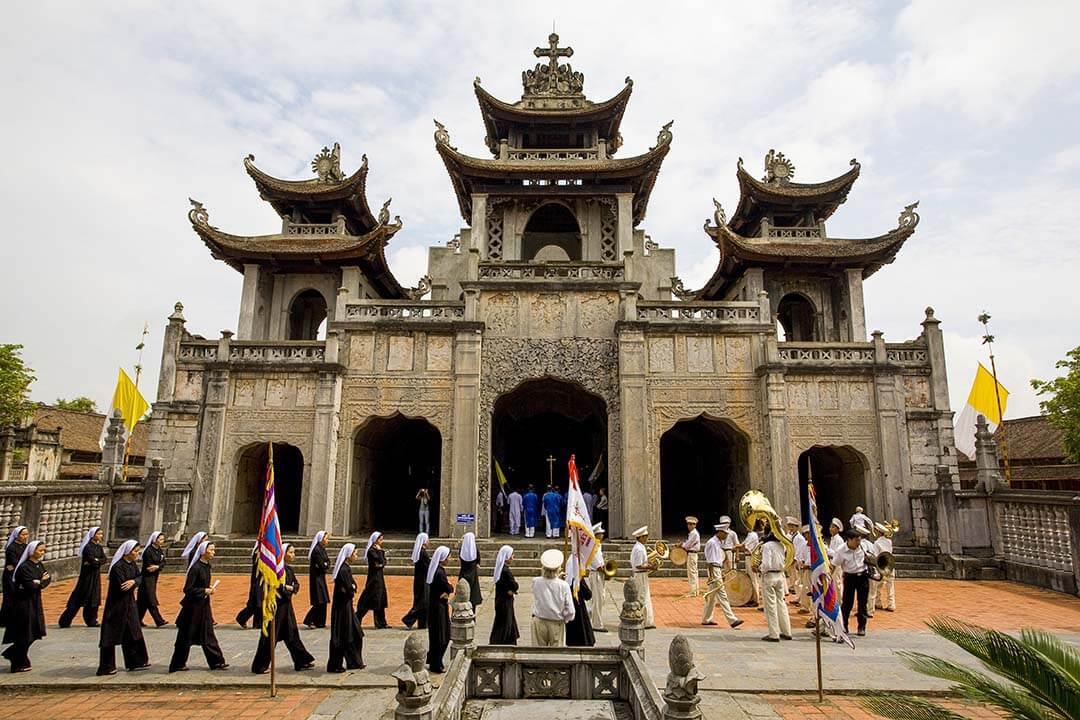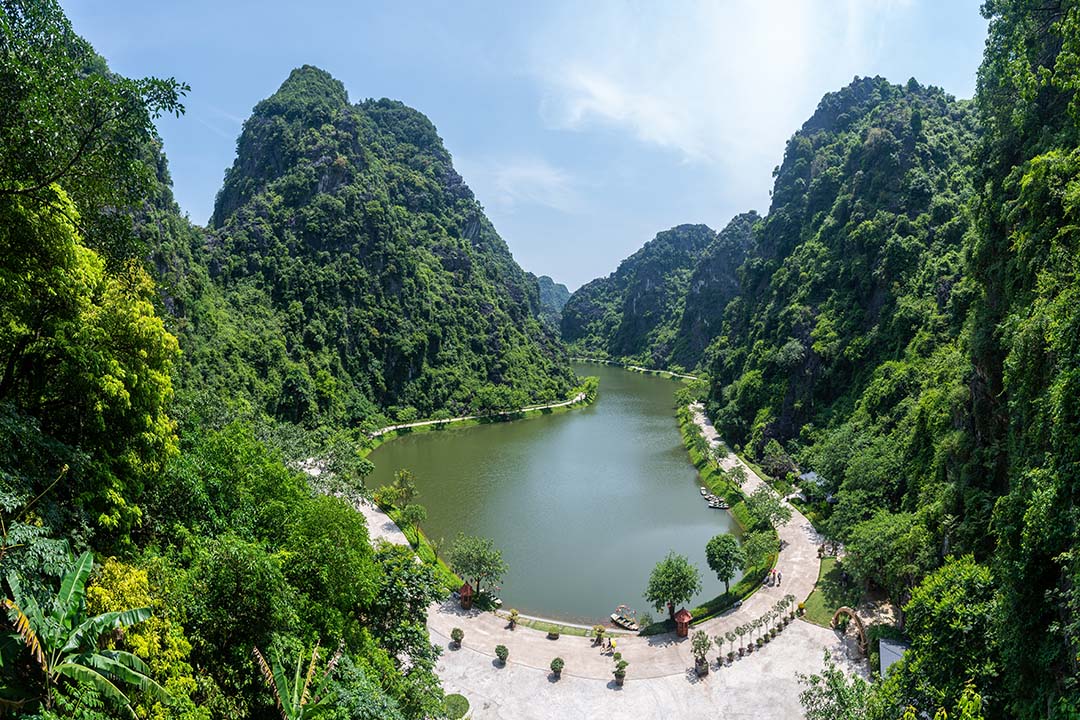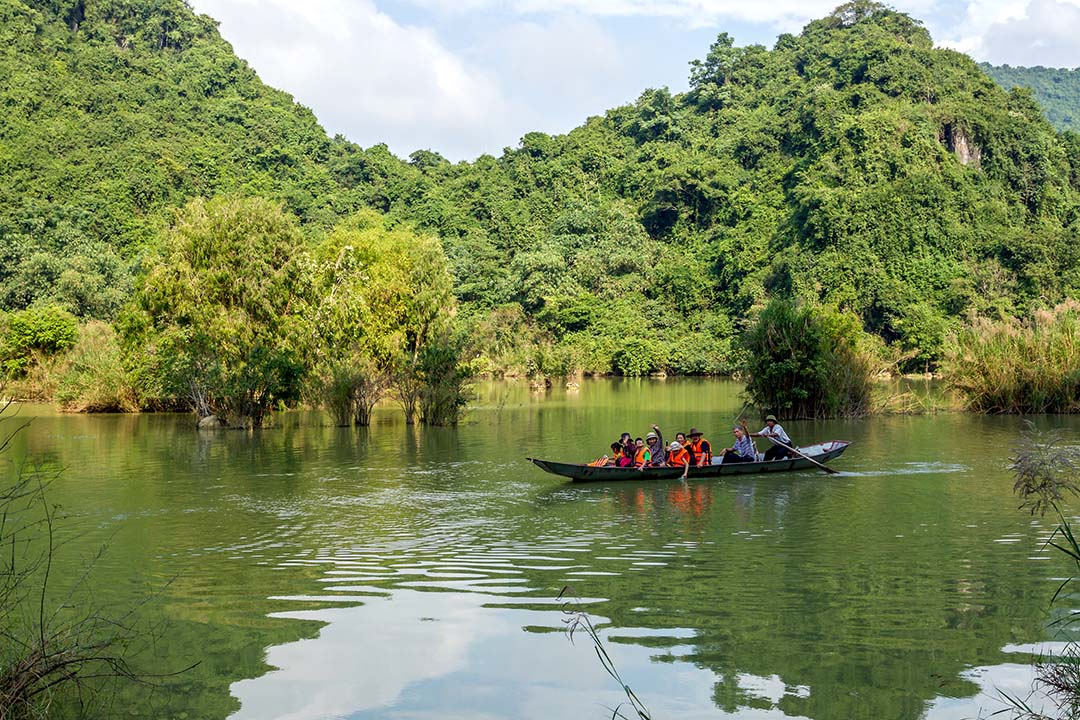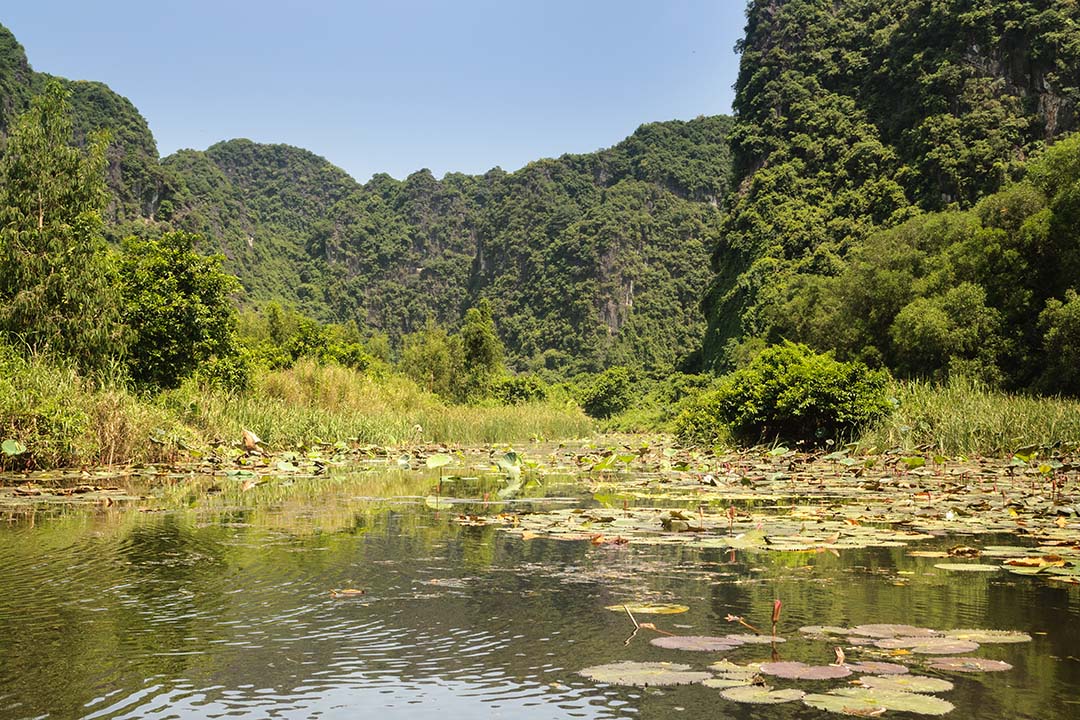Sep - 17 - 2025
The Trang An Scenic Landscape Complex is located in Ninh Binh, Vietnam. It has been recognized as a UNESCO World Heritage Site for its exceptional cultural and natural significance. This breathtaking area is known for its dramatic limestone karst mountains that rise steeply from the lush landscape. The complex features a diverse range of ecosystems, including an extensive network of caves and serene rivers.
The complex boasts several significant attractions. These include the eco-tourism area, the picturesque Tam Coc – Bich Dong, and the historic Bai Dinh Pagoda. Many scenic relics in the region were designated as particularly important national relics by the Vietnamese Government. The rich cultural heritage is complemented by stunning natural features, providing a unique opportunity to experience both history and beauty.
Approximately 14,000 residents live in this area, most of whom are engaged in subsistence agriculture. Despite this human presence, much of the landscape remains uninhabited and in a natural state. This allows for an immersive experience in the tranquility and ecological diversity of the Trang An Scenic Landscape Complex. In this article, GTrip will help you know more detailed information about Trang An.
Geography and natural features of Trang An
The Trang An Scenic Landscape Complex encompasses a remarkable area of 6,226 hectares, characterized by its unique geographical features. It is formed by stunning karst formations that dominate the landscape, creating a dramatic interplay of limestone cliffs, valleys, and waterways. These limestone landscapes give the area its distinctive appearance and contribute to its ecological significance.
The Trang An Scenic Landscape Complex includes an extensive network of rivers and caves that wind through the karst terrain. This intricate system allows for exploration by boat. Participating in boat tours is one of things to do when traveling to Ninh Binh because it offers breathtaking views of the surrounding scenery. The rivers not only enhance the beauty of the region but also support a rich biodiversity, with various plant and animal species.
The distance from the geometric center of the Trang An complex to Ninh Binh city is about 8 kilometers as the crow flies. The tourist areas are strategically located on the outskirts of the Trang An heritage complex. They guide travelers deep into the heart of this remarkable landscape.

Geography and natural features of Trang An
Features of Trang An
The Trang An Scenic Landscape Complex is rich in cultural and historical features, reflecting the heritage of Ninh Binh province. Within this area, several typical craft villages showcase the region’s artistic traditions. For instance, the embroidery village in Ninh Hai commune is renowned for its intricate textile designs. Similarly, Ninh Van commune is famous for fine art stone crafting, where skilled artisans create stunning sculptures and decorative pieces. The construction craft in Truong Yen commune highlights traditional building techniques that have been passed down through generations.
Today’s residents of Trang An are considered descendants of the ancient inhabitants of the region. This lineage connects them to the culture, which is recognized as the oldest culture in Vietnam. The cultural continuity is evident in local customs, festivals, and crafts that are still practiced today. These features not only enrich the experience of exploring but also provide insight into the deep-rooted history and traditions.
The combination of natural beauty and cultural heritage makes this place a unique destination. Travelers can enjoy the stunning landscapes while also experiencing the vibrant local culture that has evolved over centuries.

Woven pitted is historical features of Trang An
The first dual World Heritage Site in Vietnam
The Trang An Scenic Landscape Complex holds the distinguished title of being the first dual World Heritage Site in Vietnam. It meets two world natural heritage standards and one world cultural heritage standard, reflecting its exceptional value. This recognition highlights the site’s unique combination of natural beauty and cultural significance.
The first standard is the Aesthetic Criterion, which states that the heritage must contain transcendent natural phenomena or areas of extraordinary beauty and aesthetic importance. The breathtaking limestone karst mountains, lush greenery, and winding rivers of Trang An exemplify this standard. The picturesque landscapes offer a stunning visual experience, captivating all who explore its natural wonders.
The Geological Criterion also plays a vital role in its classification. This standard asserts that the heritage must represent outstanding examples of significant periods in Earth’s history. Trang An showcases remarkable geological processes, with its karst formations providing records of life and major geological changes. The complex’s unique topography illustrates the dynamic natural forces that have shaped the land over millennia.
Cultural Criterion emphasizes the importance of traditional human settlements and land use. Trang An is an outstanding example of traditional practices that reflect the area’s rich cultural heritage. The complex represents the culture of its ancient inhabitants, highlighting their sustainable land-use methods. This aspect becomes particularly significant as these traditional ways of life face challenges from modern changes.
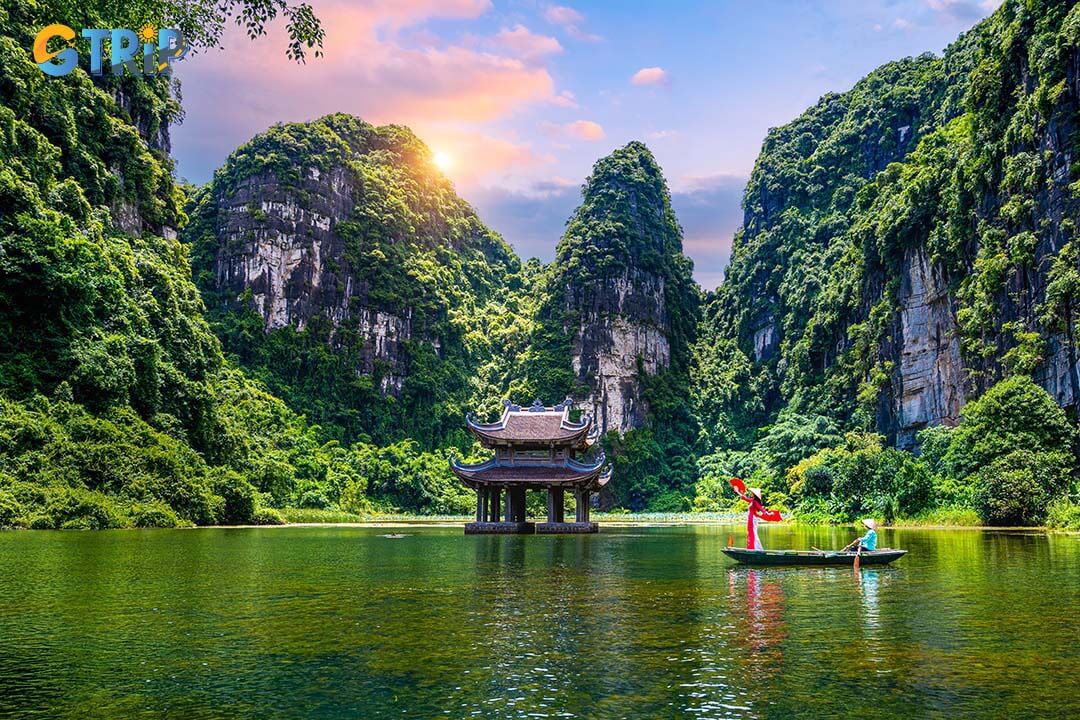
Trang An - The first dual World Heritage Site in Vietnam
Outstanding global beauty
Trang An Scenic Landscape Complex is renowned for its outstanding global beauty, showcasing a stunning blend of natural and cultural elements. The dramatic limestone karst mountains rise majestically from the landscape, creating a breathtaking visual spectacle. Their unique formations and shapes draw the admiration of all who visit.
Winding rivers flow through the valleys, reflecting the lush greenery and providing a serene atmosphere. Sunlight glistens on the water’s surface, enhancing the enchanting scenery. The area’s rich biodiversity further enriches its beauty, making it a paradise for nature lovers and photographers.
Complementing its natural splendor, Trang An is steeped in cultural heritage. Traditional craft villages and ancient relics exist alongside the striking landscapes, offering a glimpse into the region’s history. This harmonious blend creates an extraordinary experience, where the captivating scenery and vibrant local traditions come together.
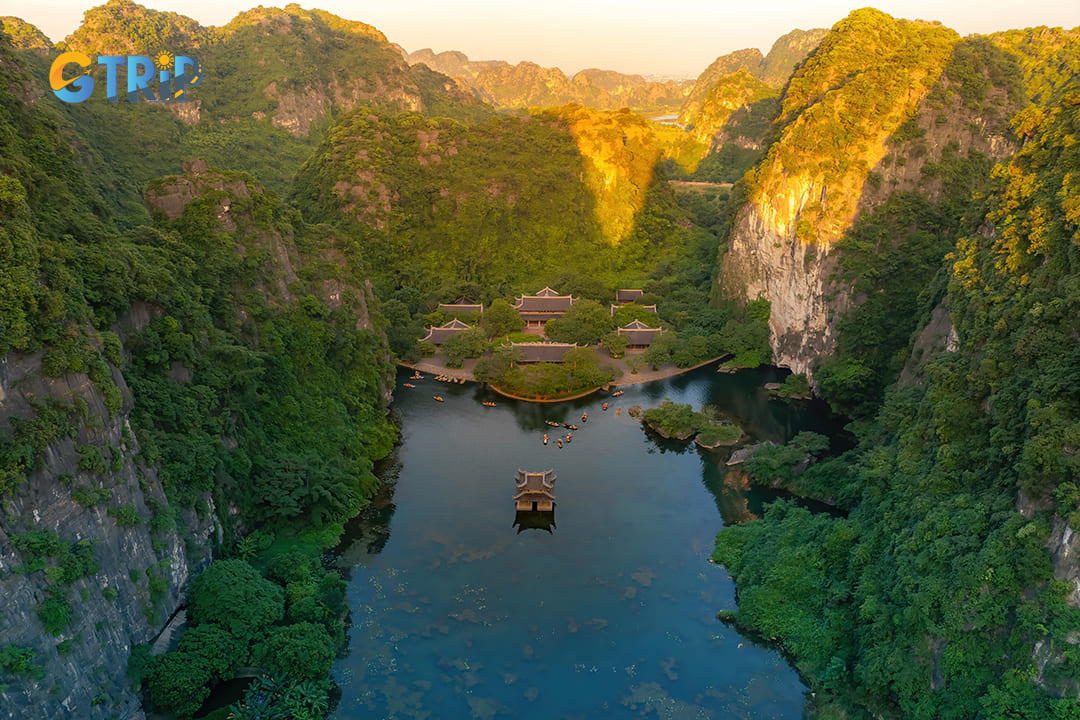
Outstanding global beauty of Trang An
Unique geological formations
Trang An Scenic Landscape Complex is famous for its unique geological formations, particularly its impressive limestone karst mountains. These dramatic structures have been shaped over millions of years through erosion and weathering. They create a captivating landscape of steep cliffs and deep valleys.
The area also features an extensive network of caves, adorned with stunning stalactites and stalagmites that showcase the natural processes at work. Exploring these caves reveals the intricate beauty formed by water and time.
Additionally, the rivers flowing through Trang An carve the landscape, contributing to its distinctive topography. This combination of water and limestone creates a remarkable setting. It serves as both a natural wonder and a vital record of the Earth’s geological history.
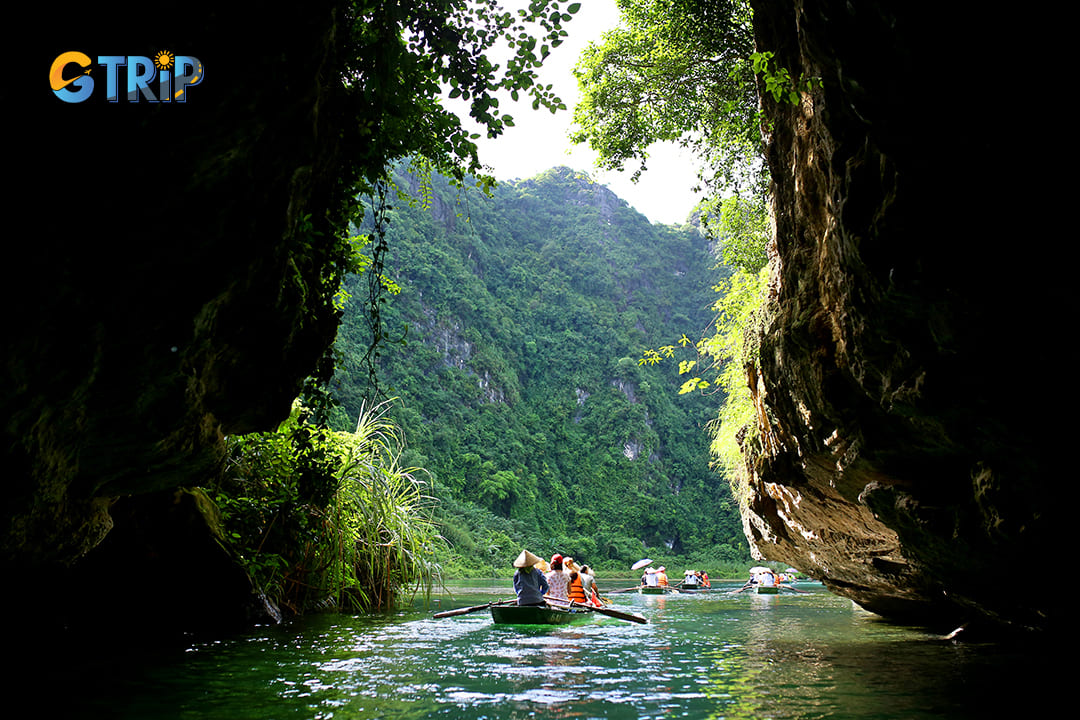
Unique geological formations of limestone karst mountains
The living environment of prehistoric people
Trang An provides valuable insights into the living environment of prehistoric people who inhabited the region thousands of years ago. Its unique geological features offered natural shelter and resources. The caves served as refuges and storage areas, protecting early inhabitants from the elements. They also provide access to materials for tools and crafts.
Additionally, the rivers and lush vegetation surrounding Trang An supplied fresh water and abundant food sources. The diverse ecosystems supported a variety of wildlife, which early humans relied on for sustenance. It is important for understanding human adaptation and survival during prehistoric times. The remnants of these ancient cultures contribute to our knowledge of life in early Vietnam.
Hoa Lu capital of Dai Co Viet country
Hoa Lu, located in Ninh Binh province, was the capital of the ancient Dai Co Viet country during the 10th century. This site became the political center under the Dinh and Le dynasties. Its strategic location, surrounded by limestone mountains and fertile plains, provided natural defenses and agricultural resources, making it an ideal capital. Hoa Lu is in close proximity to the Trang An Scenic Landscape Complex, which enhances the area’s historical and cultural significance.
As a cultural hub, Hoa Lu reflects the rich heritage of early Vietnamese civilization. Historical relics, temples, and pagodas, such as the Dinh Tien Hoang Temple and the Le Temple, showcase the architectural styles and religious practices of the time. Today, Hoa Lu is recognized as a historical site. It allows travelers to explore its ruins and learn about the events that shaped Vietnam.
You can learn more about the history of Dai Co Viet country through our article about Hoa Lu Ancient Capital
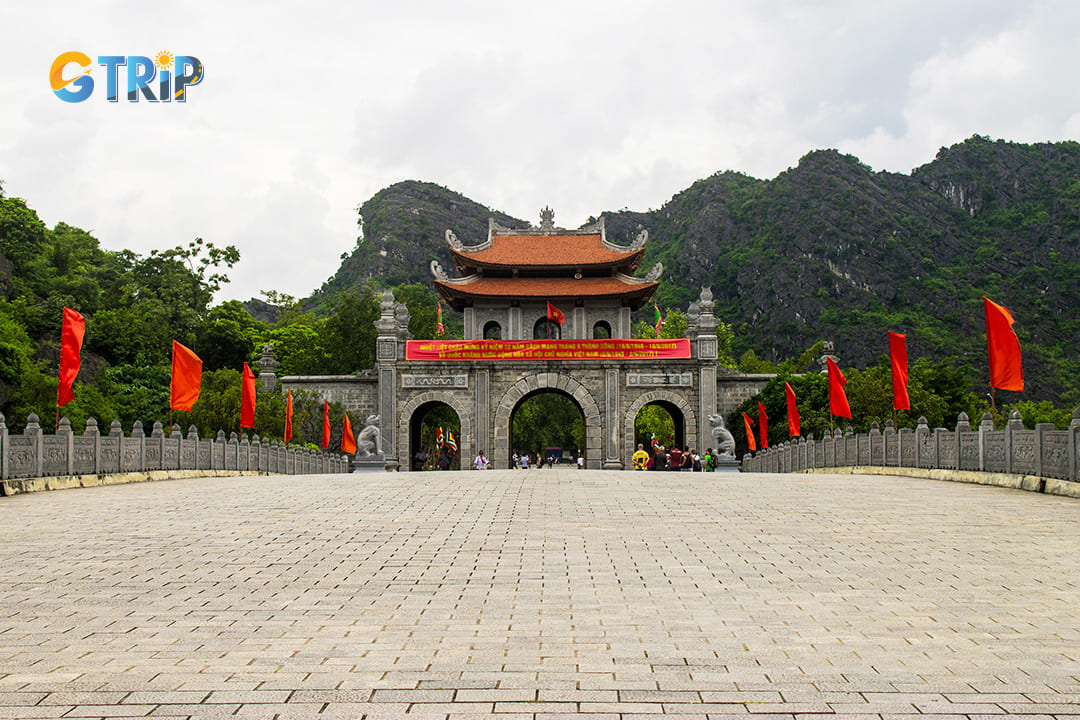
Hoa Lu Capital of Dai Co Viet - Dinh Dynasty
11 main attractions of Trang An Scenic Landscape Complex
Trang An Scenic Landscape Complex has many attractions for people to explore, but there are 11 main attractions that you can not miss when touring Trang An, Ninh Binh.
1. Natural karst tower
The karst towers of Trang An Scenic Landscape Complex offer a dramatic landscape filled with towering limestone peaks, serene valleys, and unique cave systems. These formations reach up to 200 meters and feature sharp, vertical cliffs that give the area its rugged, majestic character. Between the peaks, narrow ridges create natural walkways and offer views over the surrounding valleys.
Hidden within these valleys are natural depressions and deep sinkholes formed by centuries of erosion, often with emerald-green rivers winding through them. Some of these rivers flow into extensive cave systems that are accessible only by boat. Inside, underground passages stretch over a kilometer, revealing impressive stalactites and ancient rock formations.
Here below is Trang An Complex tourist map:
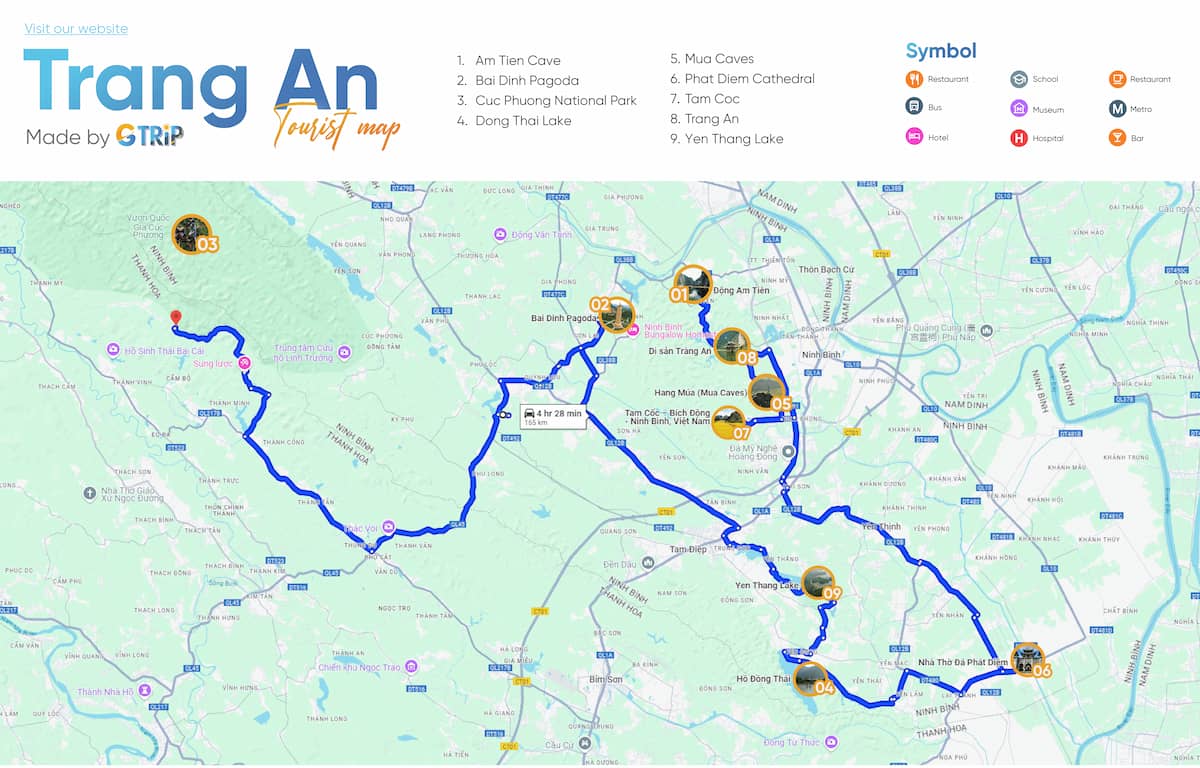
Trang An Complex tourist map
If you want to get high quality, please download Trang An tourist map with PDF type
Surrounded by clear rivers and lush tropical vegetation, the towers reflect beautifully on the water, adding depth to Trang An’s scenic beauty. Exploring by boat, travelers can appreciate the sheer height and detail of these formations, enhancing the natural and ecological value.
This area attracts nature lovers and photographers who seek to capture its majestic beauty. The combination of towering limestone and lush greenery enhances the landscape’s natural beauty, making it a must-see in Trang An Scenic Landscape Complex.
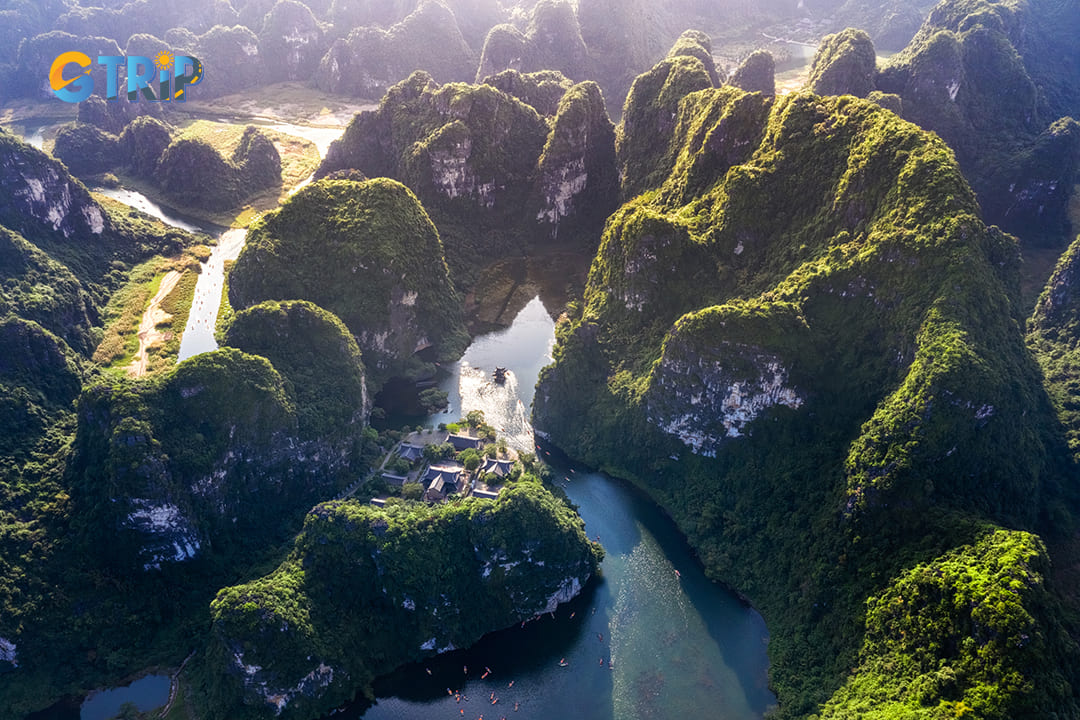
Natural karst tower of Trang An
2. Trang An grottoes
Trang An grottoes feature an extensive network of caves and tunnels formed over millennia, showcasing the area’s geological diversity. These grottoes include over 50 caves, with some of the most notable being Sang Cave, Toi Cave, and Nau Ruou Cave. The caves, stretching between towering limestone peaks, vary in size and shape, creating an otherworldly experience for those who venture inside. In some caves, you can see rare stalactites that have formed unique patterns, adding a sense of mystery and ancient beauty to the underground passages.
Boat tours are the only way to explore the Trang An Grottoes and are a major attraction here. Guided by skilled local rowers, travelers glide along calm rivers, passing through intricate cave systems and witnessing the pristine natural environment up close. The tour often stops at different caves and small temples, providing moments to appreciate both nature and culture. The boats carry up to four people and follow routes that take you through several interconnected grottoes to experience the unique topography and geological formations of the place.
There are three main routes, each lasting about 2-3 hours, allowing you to glide through iconic caves, where you can see rare stalactites and intriguing rock formations. Each route showcases different elements, with one focusing on extensive cave exploration, another on cultural sites like Den Trinh Temple, and a balanced route that combines both.
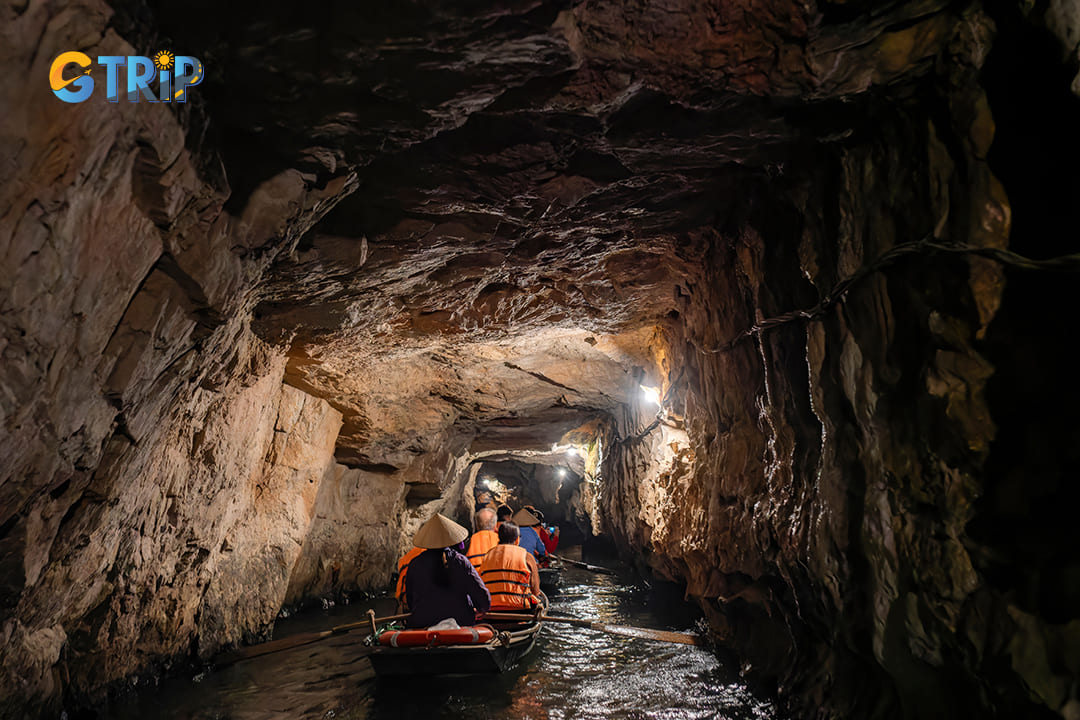
Boat tours to explore the Trang An Grottoes
3. Tropical forests and rivers surrounding Trang An
The tropical forests and rivers surrounding the Trang An Scenic Landscape Complex consist of lush ecosystems. These ecosystems play a crucial role in the region’s biodiversity. The forests are home to a variety of native flora and fauna, including rare species like Delacour’s langur, civets, and numerous bird species. This makes the area a biodiversity hotspot.
Towering ancient trees and a wide range of tropical plants cover the landscape. They create an enchanting green canopy that cools and shades the rivers below. The scenic views along the winding rivers enhance the natural beauty of the landscape. This setting provides a serene retreat for those who enjoy nature.
Travelers can take guided boat tours along these rivers, which provide a serene and immersive way to experience the forest’s untouched beauty. Along the way, the boat journeys through interconnected caves and rock passages, offering glimpses of hidden ecosystems and geological formations.
Beyond the boat tours, the forested areas offer excellent opportunities for wildlife spotting and birdwatching. Those interested in exploring further can take eco-friendly guided walking tours along forest trails. You can learn about native plants, conservation efforts, and the role of the forest in the local ecosystem. You can discover the interplay of water and forest, experiencing the harmony that defines the beauty of Trang An Scenic Landscape Complex.

Tropical forests and rivers surrounding Trang An
4. Relic sites in Trang An Complex
The relic sites within the Trang An Scenic Landscape Complex hold significant historical value, showcasing Vietnam’s rich cultural heritage. These sites consist of ancient temples, pagodas, and remnants from various dynasties, particularly the Dinh and Le dynasties. Notable sites include Den Trinh, Den Tho Tran, and Suoi Tien Temple. Each of these locations showcases traditional Vietnamese architecture with detailed carvings, wooden pillars, and tiled roofs, representing the spiritual heritage of the region.
The relic sites display traditional Vietnamese architecture, with sloping tiled roofs, carved wooden pillars, and stone statues. Many temples blend into the limestone cliffs, reflecting a harmonious connection with nature. Their ornate carvings, bronze bells, and altars honor Vietnam’s history and spiritual heritage, showcasing the artistry and cultural depth of the region.
These relics are accessible through guided boat tours along scenic rivers, allowing travelers to disembark at each site to explore its history and unique architecture. Some sites are also reachable by forested trails, offering an immersive experience that combines natural beauty with cultural exploration.
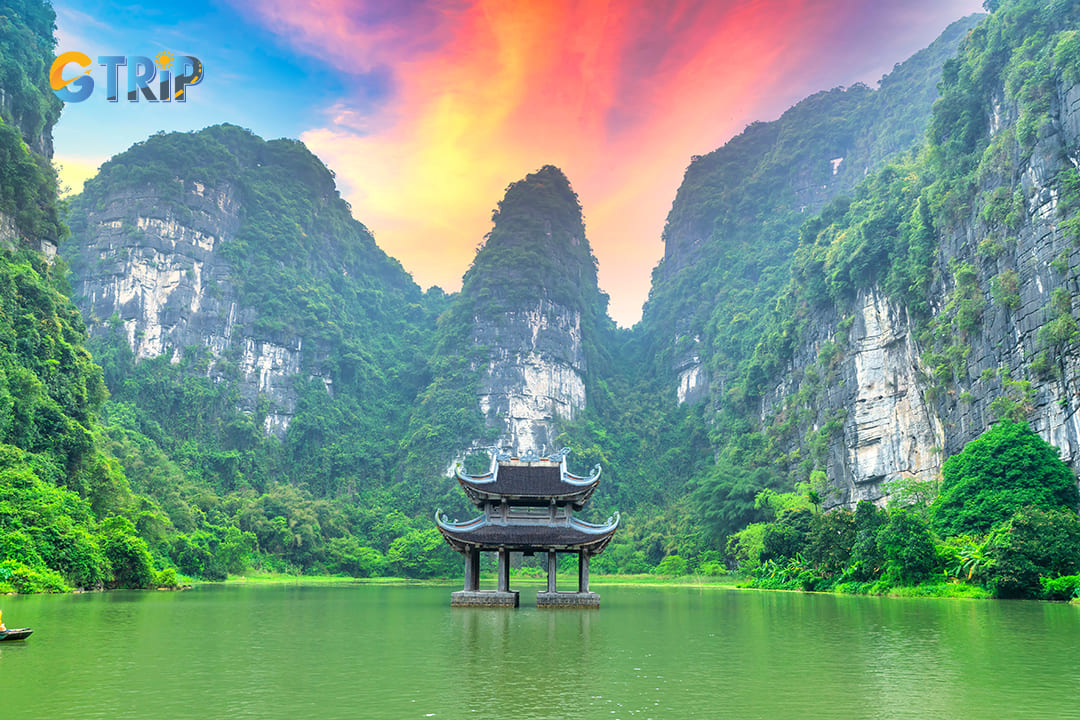
Relic sites in Trang An Complex
5. Tribal village in Kong
The Tribal Village in Kong, located within Trang An Scenic Landscape Complex, was originally created as a filming set for the movie Kong: Skull Island. Although fictional, the village offers a cultural experience inspired by traditional ethnic communities in Vietnam. It particularly draws from the Muong and Thai ethnic groups. The recreated village reflects unique aspects of tribal life. Stilt houses made from bamboo and wood, hand-crafted decorations, and outdoor fire pits add to the authentic atmosphere.
Exploring the Tribal Village offers a fascinating glimpse into the rustic, communal lifestyle of these ethnic groups. You will see villagers dressed in traditional costumes, showcasing age-old crafts such as weaving and basket-making. Local artists also perform traditional songs and dances, bringing the village to life. This immersive experience provides insight into the cultural practices and values of Vietnam’s ethnic communities, highlighting their deep respect for nature and close-knit social bonds.
Guided tours allow travelers to walk through the village, interact with locals, and learn about the craftsmanship involved in building the village’s structures. There are also photo opportunities with set pieces from the movie, blending film history with authentic cultural exploration. For those interested in Vietnam’s ethnic heritage, the Tribal Village in Kong offers a memorable, hands-on experience.

Tribal village in Kong
6. Mua Cave
Mua Cave, set at the base of a limestone mountain in Trang An Scenic Landscape Complex, offers sweeping views over Tam Coc’s rice fields and rivers. Though small, its main appeal is the 500-step climb to the peak, which rewards you with panoramic views of Ninh Binh’s landscape, including lush fields, rivers, and limestone peaks. The summit features a dragon statue and temple, both popular for photos, especially at sunrise or sunset.
Hiking to Mua Cave is a popular activity, allowing explorers to appreciate the unique geological formations and the expansive views of the Trang An Scenic Landscape Complex. The climb is challenging but rewarding, with multiple viewpoints along the way that allow you to stop, rest, and take in the surrounding scenery. On Vietnam’s holidays such as September 2nd, along with the climb to the peak, there will be a line of Vietnam flags. This makes the Mua Cave more stunning and attractive to foreigners and Vietnamese as well.

Hiking to Mua Cave
7. Thien Ha cave
Thien Ha Cave is located within the Trang An Scenic Landscape Complex, is renowned for its stunning geological formations. Stretching over 1,200 meters, the cave features enchanting stalactites and stalagmites, each formed over thousands of years. The unique shapes and colors of the rocks create a captivating underground landscape that intrigues all who visit.
You can explore Thien Ha Cave through guided boat tours, which provide a relaxing journey along tranquil rivers leading to the cave entrance. The scenic ride offers breathtaking views of the surrounding karst mountains and lush greenery, enhancing the anticipation of the cave exploration. Inside, travelers navigate narrow passages illuminated by colorful lights that accentuate the cave’s natural beauty. Activities include admiring rock formations, taking photographs, and learning about the cave’s geological significance and local legends from knowledgeable guides.

Explore Thien Ha Cave
8. Tam Coc – Bich Dong
Tam Coc – Bich Dong is a breathtaking area known for its picturesque rice paddies and limestone mountains. This stunning landscape consists of unique geological formations and cultural landmarks, including ancient temples. The historical significance of Tam Coc is evident in its connection to early Vietnamese civilization, making it a site of both natural and cultural relevance.
The region attracts those seeking scenic views and a tranquil atmosphere. Boat tours along the Ngo Dong River allow for intimate exploration of the rice fields and stunning karst formations. This immersive experience highlights the natural beauty of the surroundings while providing insight into the local agricultural practices.
The Festival on the River in Tam Coc – Bich Dong is a vibrant celebration held annually to honor the agricultural practices and cultural heritage of the local community. This festival typically takes place in the spring, coinciding with the rice-growing season. Participants engage in various traditional activities, including boat races, folk performances, and ceremonies to pay homage to the river and its significance in local life.
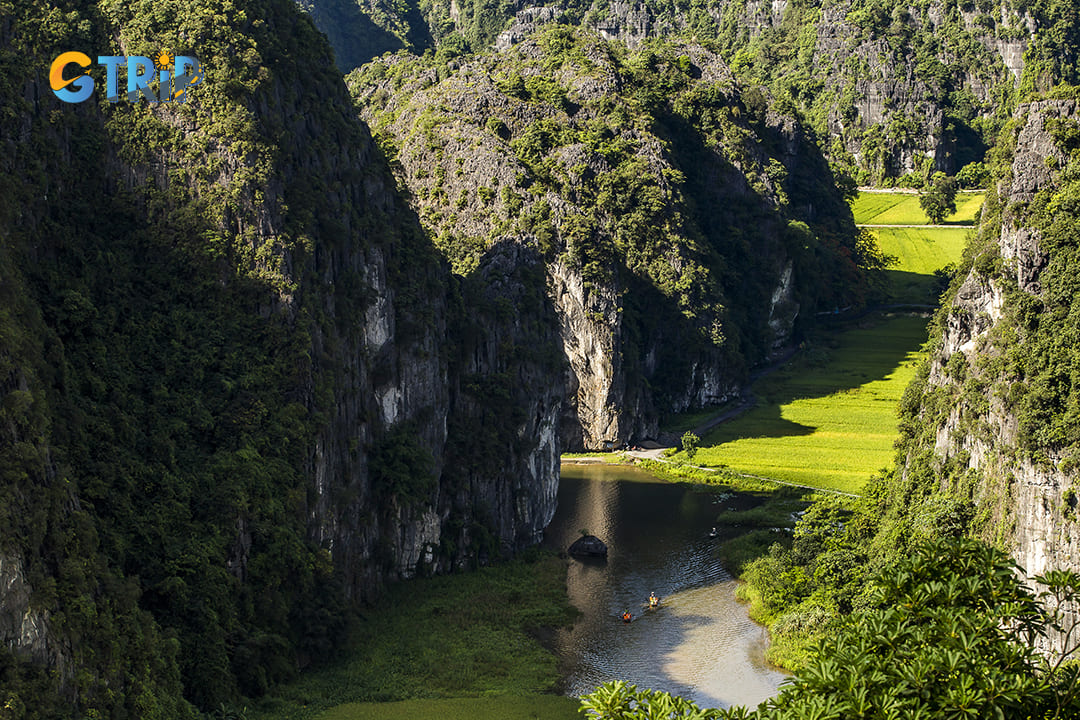
Tam Coc – Bich Dong near Trang An
9. Bai Dinh Pagoda
Bai Dinh Pagoda, located in the Trang An Scenic Landscape Complex, is one of Vietnam’s largest and most significant Buddhist temples. Covering over 539 hectares, the complex features a blend of traditional Vietnamese architecture and modern design. It is home to the largest bronze Buddha statue in Southeast Asia, standing 10 meters tall, and showcases intricate carvings and beautifully landscaped gardens. You can explore various shrines and halls, each highlighting the spiritual and historical significance of the site.
You can take meditation sessions, prayer, and guided tours that provide insights into the temple’s rich history and architectural features here. The site offers stunning views of the surrounding landscapes and limestone mountains, making it a great spot for photography and reflection. The tranquil atmosphere, combined with the majestic surroundings, creates a profound spiritual experience for all who visit.
The pagoda also hosts vibrant festivals, particularly the Bai Dinh Pagoda Festival, held annually from the first to the third month of the lunar calendar. This event draws thousands of pilgrims and tourists who come to participate in traditional rituals, folk games, and artistic performances.
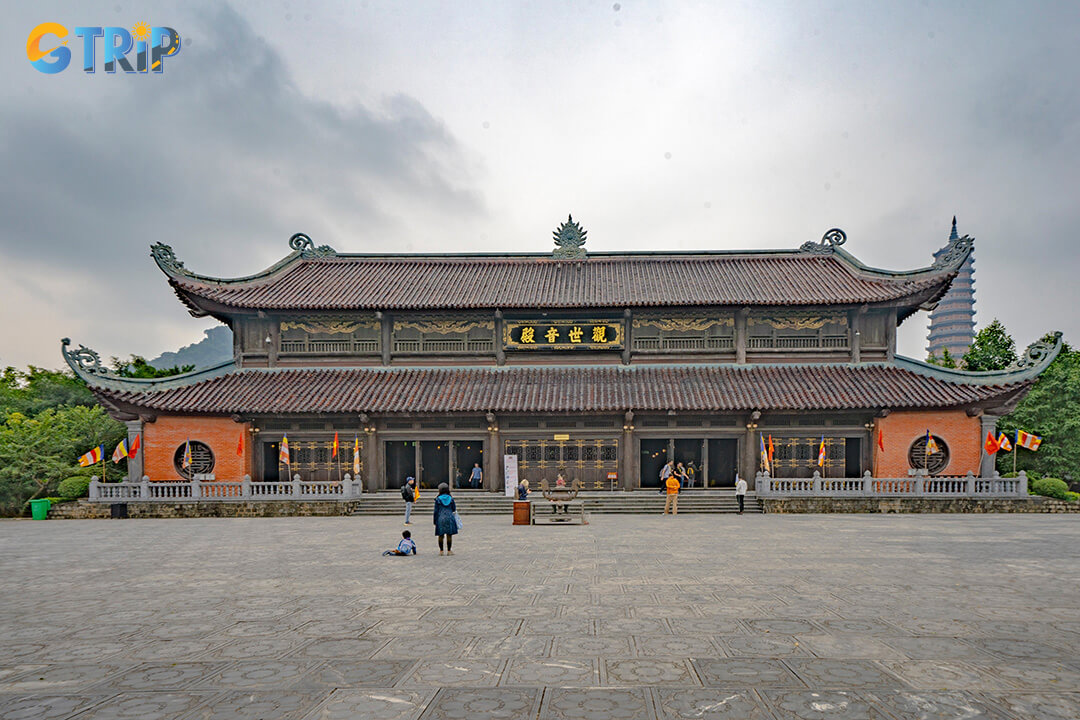
Bai Dinh Pagoda located in the Trang An Scenic Landscape Complex
10. Thung Nham tourist area
Thung Nham, situated within the Trang An Scenic Landscape Complex, is a captivating tourist area renowned for its stunning natural beauty. The landscape features lush greenery, limestone mountains, and tranquil rivers, creating a serene environment. Thung Nham is particularly famous for its karst formations and rich biodiversity, making it an ideal destination for nature lovers and adventure seekers. The area’s picturesque scenery offers countless opportunities for photography and relaxation.
The ecosystem of Thung Nham is vibrant and diverse, supporting a wide range of flora and fauna. Lush tropical forests are home to numerous plant species, some endemic to the region. The area also includes wetlands and limestone cliffs that enhance its ecological significance. Notably, Thung Nham hosts a bird sanctuary. This sanctuary provides a safe habitat for various bird species, including rare and migratory ones. As a result, it has become a crucial site for conservation efforts.
People can engage in a variety of activities that showcase the area’s natural beauty and cultural richness. Boat tours along the rivers offer a unique perspective of the stunning landscapes, while hiking trails allow exploration of diverse ecosystems. Cultural experiences, including traditional performances and local cuisine, further enhance the visit.
You can learn more details about the tourism activities of this place through GTrip’s article about Thung Nham
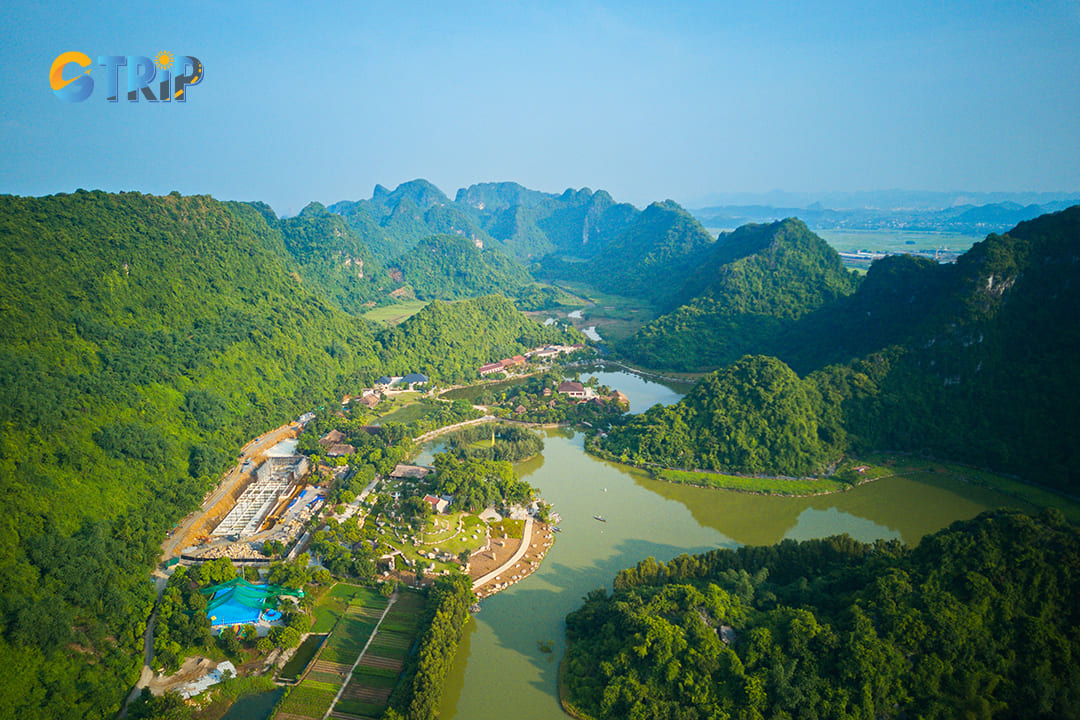
Panorama view of Thung Nham tourist area
11. Vu Lam palace
Vu Lam, located within the Trang An Scenic Landscape Complex, is a historical site rich in cultural heritage. It features stunning natural surroundings, including impressive limestone karst formations, lush greenery, and winding rivers.
The architecture of Vu Lam reflects traditional Vietnamese design, utilizing natural materials like wood and stone. Key structures include temples and pavilions that honor historical figures from the Dinh and Le dynasties. These buildings boast intricate carvings and decorative motifs. They showcase the craftsmanship of local artisans while harmonizing with the surrounding environment.
You can engage in various activities that highlight its historical significance and natural beauty. Exploring on foot allows for a closer look at architectural features and scenic views. Boat rides along nearby rivers offer unique perspectives of the landscape and stunning karst formations. Cultural events and festivals are often held here, showcasing traditional music and dance, providing an immersive experience of local customs and heritage.
One of the most notable events is the Vu Lam Festival, typically held in the first month of the lunar calendar. This festival honors historical figures associated with the palace, featuring traditional performances, local cuisine, and various cultural activities. Additionally, Lunar New Year is celebrated with great enthusiasm in Vu Lam. During this time, locals engage in various rituals and festivities that include offerings, traditional music, and dance performances.
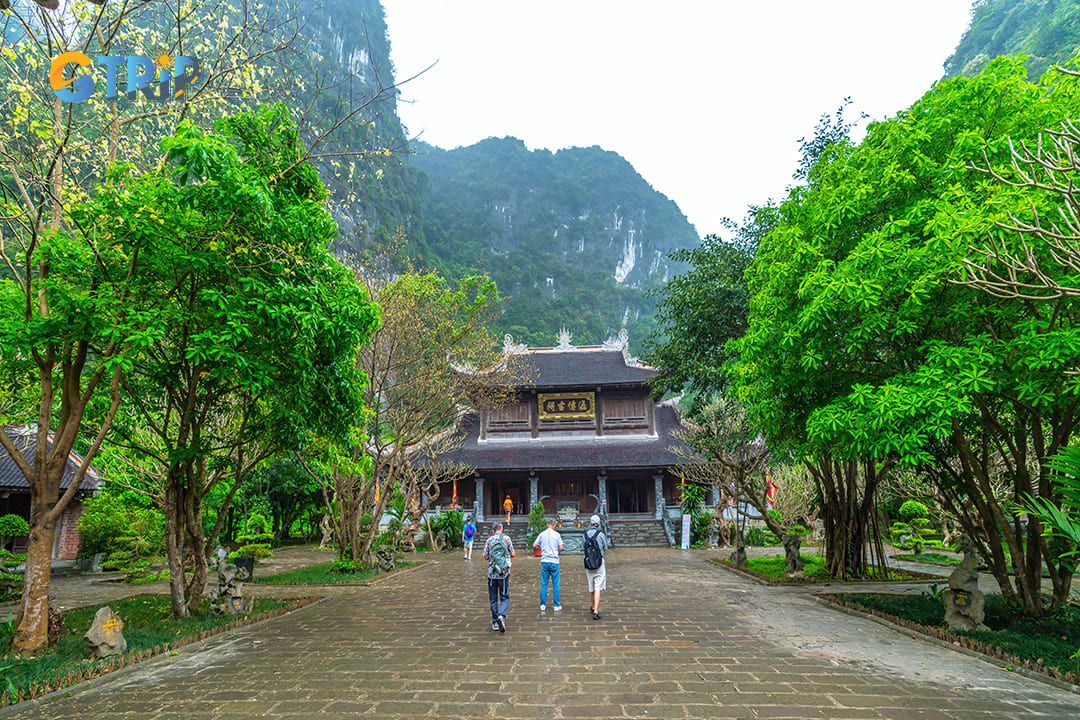
Entrance of Vu Lam Palace
Trang An cave system: Exploration and activities
The Trang An Cave System offers an unforgettable experience for those seeking adventure tourism. Boat tours lead travelers through its notable caves, each showcasing distinct geological and scenic features.
Tam Coc
Tam Coc, or the Three Caves, consists of Hang Ca, Hang Hai, and Hang Ba. These caves are connected by the river, creating a seamless journey through darkened passages and stunning limestone formations. Here, the surrounding rice paddies and karst mountains enhance the scenic views, offering both tranquility and adventure.
Thung Nang Cave
Thung Nang also known as Sunshine Valley, blends narrow passages with breathtaking open areas. The cave opens into a serene valley surrounded by lush cliffs, featuring stunning stalactites and stalagmites formed over millennia. This blend of geological beauty and peaceful scenery makes it an ideal stop for nature lovers.
Ba Giot Cave
Ba Giot Cave, or Three Drops Cave, is famed for its three striking stalactites and rich local legends. The narrow paths within add a sense of mystery, while the boat tour provides close views of intricate rock formations. This cave is perfect for those interested in the unique folklore and geological charm.

Boat tour at Ba Giot Cave or Three Drops Cave
Cultural and religious sites in Trang An
The Trang An Scenic Landscape Complex is home to a wealth of cultural and religious sites that showcase the region’s deep spiritual roots. This area holds revered temples and pagodas, each with unique cultural significance and beautiful architecture. It attracts those interested in spiritual tourism and heritage preservation. These sites serve as places of worship and symbols of Vietnam’s resilience, carefully preserved over centuries.
Den Trinh and Den Tho Tran are especially notable for their religious importance and historical heritage. Den Trinh, also called the Presentation Shrine, features intricate carvings and statues honoring deities and heroes from Vietnamese history. Den Tho Tran, dedicated to Tran Hung Dao, a national hero, celebrates his legacy of protecting Vietnam. Both temples host annual festivals that showcase local traditions, uniting communities and travelers in vibrant displays of customs and rituals.
These sites offer insight into Vietnamese beliefs while playing a key role in heritage preservation. Festivals and worship ceremonies strengthen community bonds and connect people to Vietnam’s spiritual heritage. Here are some festivals and their meanings.
- Trang An festival: Celebrates the natural beauty and cultural significance of the area, promoting community spirit and tourism.
- Bai Dinh Pagoda festival: Honors Buddha and local deities, emphasizing spiritual tourism and community engagement.
- Tam Coc – Bich Dong festival: Highlights the stunning landscapes and fosters appreciation for environmental preservation.
- Tet Nguyen Dan (Lunar New Year): Symbolizes renewal and unity, celebrating family and cultural heritage.
- Vu Lam festival: Commemorates historical figures, promoting cultural preservation and community pride.
- Gio Mien festival: Honors the agricultural spirit and expresses gratitude for a bountiful harvest.

Cultural and religious sites in Trang An
Biodiversity and ecosystem of Trang An
According to the Ministry of Natural Resources and Environment (Vietnam), biodiversity in Trang An Scenic Landscape Complex is reflected by various species and genes of many rare animals and plants. The complex supports a wide array of plant and animal species, making it a significant site for ecological value. This region is home to 134 plant families with 577 species, including 10 species listed in Vietnam’s Red Book. Seven of these plant species were recorded in Vietnam for the first time, enhancing unique biodiversity.
Among its rich flora, Trang An hosts around 311 vascular plant species commonly used in traditional herbal medicine. These species add cultural importance to the biodiversity here, as well as contribute to local conservation efforts by raising awareness of their ecological significance.
Trang An Scenic Landscape Complex’s wetlands and forests are inhabited by many rare and endangered animals, including the Delacour’s langur, pangolin, and civet. Additionally, species like otters, the striped tortoise, herons, and lesser whistling ducks enrich the ecosystem, demonstrating the variety of wildlife that thrives in these protected environments.
Conservation efforts in Trang An focus on preserving these species and their natural habitats. By supporting sustainable tourism, it balances ecological preservation with public enjoyment, encouraging respect for its rich biodiversity. This approach not only protects local species but also enhances the experience for travelers who appreciate the region’s natural beauty.
Endemic species in Trang An Scenic Landscape Complex, such as specialized plants and rare animals, highlight its value as a sustainable tourism site. These efforts in habitat protection contribute significantly to preserving the ecosystem while allowing travelers to connect with Vietnam’s natural and cultural heritage.
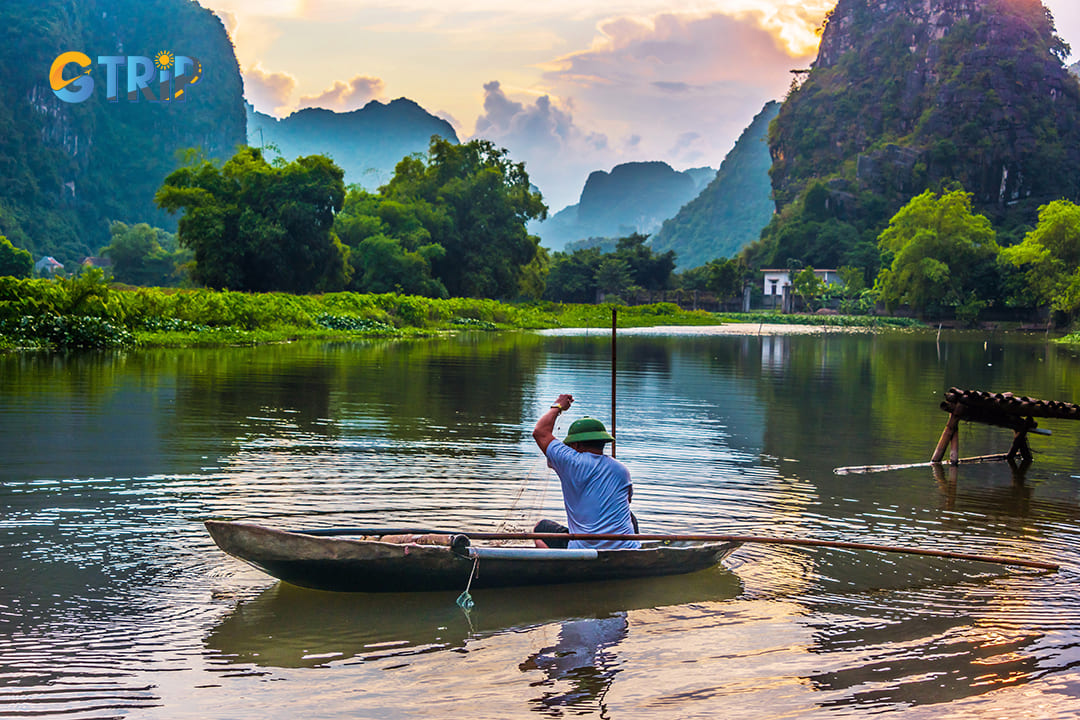
Biodiversity and ecosystem of Trang An
FAQs about Trang An – Ninh Binh
Here are some FAQs about Trang An in Ninh Binh.
Q: Trang An’s role in sustainable tourism
A: Trang An Scenic Landscape Complex promotes sustainable tourism by strictly adhering to UNESCO guidelines that prioritize environmental protection and responsible travel. As a UNESCO World Heritage Site, it attracts eco-conscious travelers interested in eco-tourism and experiencing Vietnam’s natural and cultural beauty responsibly.
The region’s sustainable practices include minimizing waste, preserving natural landscapes, and supporting local conservation efforts. These practices aim to protect the natural ecosystem, ensuring that future generations can enjoy Trang An’s beauty. By focusing on responsible travel, it sets a strong example in sustainable tourism, making it a key destination for ecotourism enthusiasts.
Q: How to visit Trang An: Transportation and tips
A: Trang An Scenic Landscape Complex can be reached by multiple transportation options from Hanoi. Travelers often choose buses, trains, or private cars to reach Ninh Binh, with the journey taking about 2–3 hours. Once in Ninh Binh, local taxis, motorbikes, or bicycles are available to explore the area conveniently.
Trang An Scenic Landscape Complex is best visited during spring (February – April) or autumn (September – November) when the weather is pleasant. The scenic boat tours offered here are enhanced by these seasons, making it easier to enjoy the region’s beauty without extreme temperatures.
It’s recommended to bring comfortable clothing, sun protection, and water, as the boat tours can last several hours. Travelers can also book guided tours, which often include transportation, to learn more about history and natural significance.
Q: Why Trang An is a must-visit destination
A: Trang An Scenic Landscape Complex is considered one of Vietnam’s most unique destinations, offering an immersive experience that combines natural beauty, cultural heritage, and historical significance. This area stands out as a landscape of striking karst formations, winding rivers, and lush greenery. Boat tours provide stunning views, weaving through caves, wetlands, and temple sites, offering a distinctive experience found nowhere else.
The region is not only beautiful but also deeply historical. It allows travelers to explore ancient temples and sacred sites, providing insight into Vietnam’s past. The area’s natural beauty and cultural significance make it a must-visit for those seeking a rich, meaningful journey.
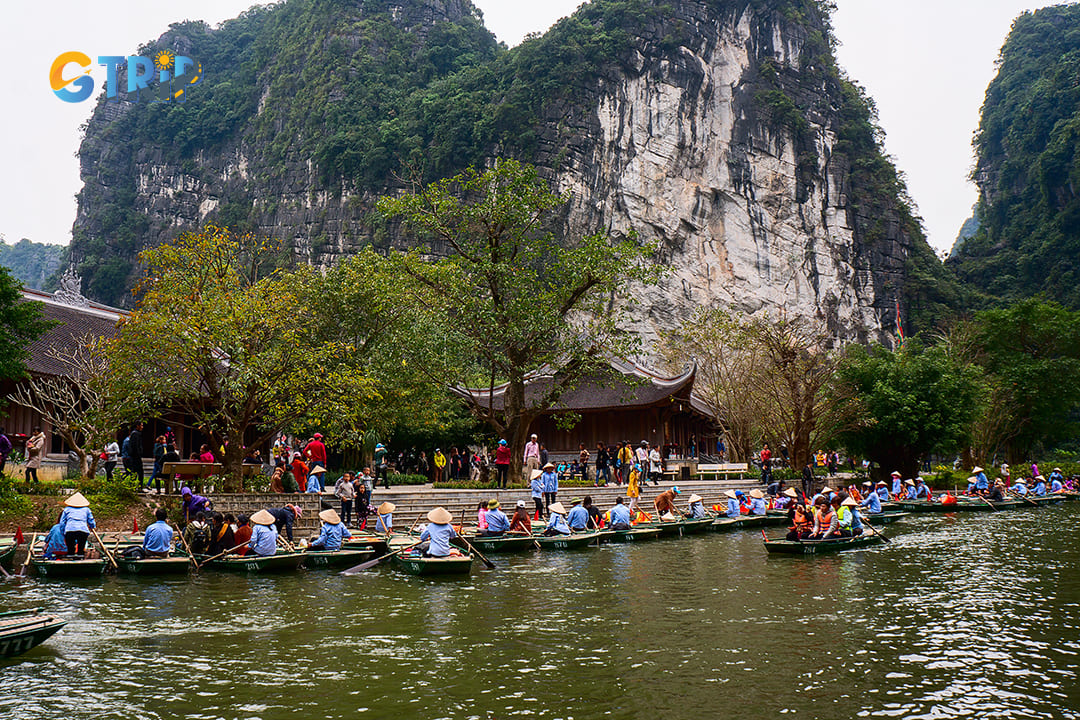
A large number of tourists visit Trang An by boat tour
Q: The different between Trang An and Tam Coc – Bich Dong
A: Though both Trang An and Tam Coc – Bich Dong feature limestone mountains and riverboat tours, they offer distinct experiences. Trang An is a larger complex with a more intricate cave system. It allows for longer boat journeys through several interconnected caves and temples. This experience emphasizes the role as both a cultural and ecological treasure.
In contrast, Tam Coc is known for its serene rice paddies and the Three Caves, which provide a shorter, more intimate tour. The landscape is more open and peaceful, often considered more relaxing and suitable for travelers seeking a tranquil escape in a picturesque setting.
Q: How much does it cost to go to Trang An?
A: The entrance fee to Trang An includes the boat tour, which is essential to exploring the area’s interconnected caves and temples. Tickets generally cost between 200,000 to 250,000 VND (about $8–10 USD) per person, though prices may vary slightly depending on the season or specific packages offered.
Additional costs may apply for guided tours, which provide more context and insights into unique features. For those seeking a more in-depth experience, investing in a guide can add value. A guide enhances understanding and appreciation of the area’s natural and cultural highlights.





